Suite de collaboration Zimbra (ZCS) est une plateforme collaborative Open Source pour serveurs de messagerie, développée en deux éditions, Édition Open Source (Libre) et Édition réseau (Payé), qui fournit des services tels que LDAP, SMTP, POP et IMAP, client de messagerie Web, calendrier, tâches, antivirus, antispam et autres.
Ce tutoriel décrit comment installer Édition Open Source de Zimbra Collaboration Suite sur un CentOS / RHEL 7 serveur.
Exigences
Étape 1: installer les packages système
1. Avant de procéder au processus d’installation de Zimbra Collaboration Suite, connectez-vous d’abord à la console de votre serveur avec les privilèges root et installez les packages suivants:
# yum -y install unzip net-tools sysstat openssh-clients perl-core libaio nmap-ncat libstdc++.so.6

2. Prochain sujet getenforce pour vérifier si Selinux est activé sur votre machine. Dans le cas où la politique est définie sur Enforced désactivez-le en exécutant les commandes ci-dessous:
# getenforce # setenforce 0 # getenforce

Pour désactiver complètement Selinux sur CentOS, ouvrez /etc/selinux/config fichier avec un éditeur de texte et définissez la ligne SELINUX à disabled.
3. Assurer que utilitaire système wget est également installé sur votre système en exécutant la commande suivante:
# yum install wget
Étape 2: configuration du nom d’hôte du système
4. Afin de Zimbra pour fonctionner correctement, vous devez définir le nom d’hôte de la machine locale et FQDN pour pointer vers l’adresse IP de votre serveur en exécutant la commande ci-dessous commandes hostnamectl depuis le compte root:
# hostnamectl set-hostname mail # echo "192.168.0.14 mail.centos7.lan mail " >> /etc/hosts # cat /etc/hosts
Remplacez le nom d’hôte du système et les valeurs FQDN en conséquence afin de correspondre à vos propres paramètres de domaine. Testez les valeurs de nom d’hôte et de nom de domaine complet en émettant le commande ping contre les deux records.
# ping -c1 mail.centos7.lan # ping -c1 mail
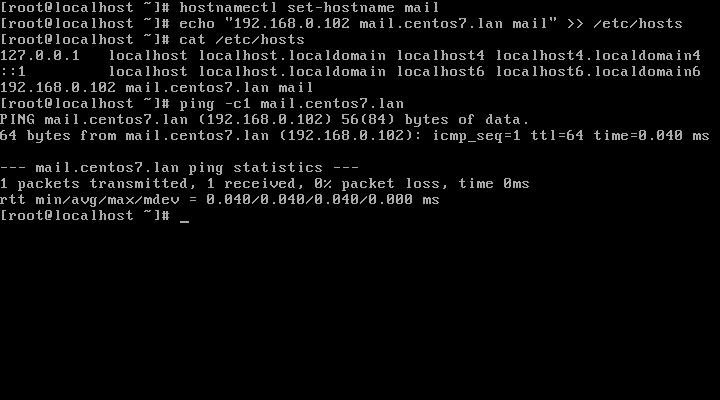
Étape 3: Ajouter une adresse IP statique
5. Si votre serveur utilise une adresse IP dynamique DHCP, vous devez modifier votre carte d’interface réseau et la configurer pour utiliser une adresse IP statique. Obtenez les informations sur l’interface réseau en utilisant commande ip addr et identifiez la carte réseau externe de votre serveur (généralement quelque chose comme enp0s3 ou eth0).
# ip addr
Ensuite, exécutez le commande nmtui-edit par rapport à l’interface, vous devez modifier les paramètres et attribuer à l’interface une adresse IP manuelle. Utilisez les captures d’écran ci-dessous comme guide.
# nmtui-edit enp0s3
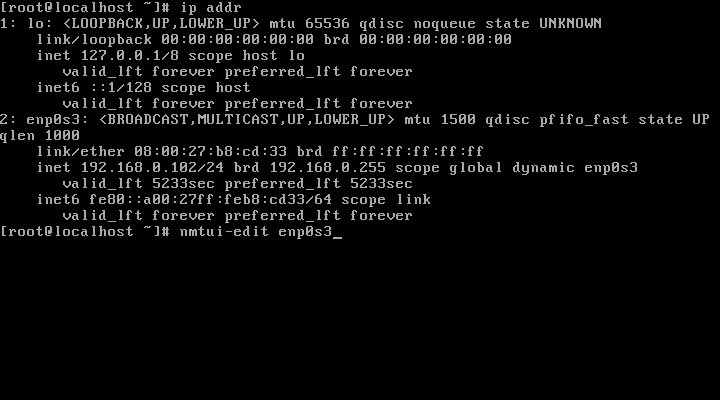
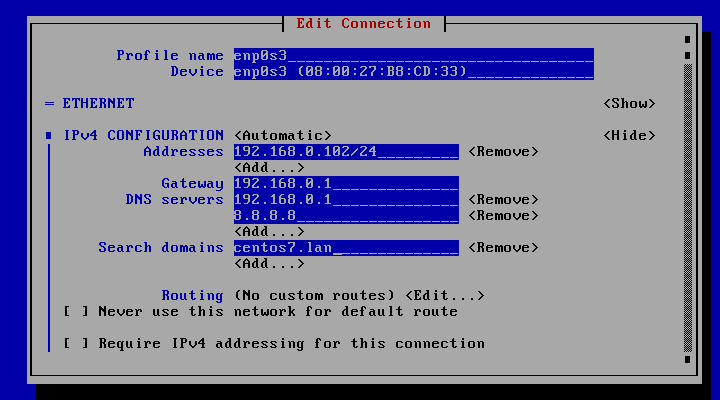
Étape 4: Désactivez les services indésirables
6. Une installation par défaut de CentOS est livrée avec suffixe démon déjà installé et en cours d’exécution. Pour désactiver et effacer le service postfix, exécutez les commandes suivantes:
# systemctl stop postfix # systemctl disable postfix # yum remove postfix
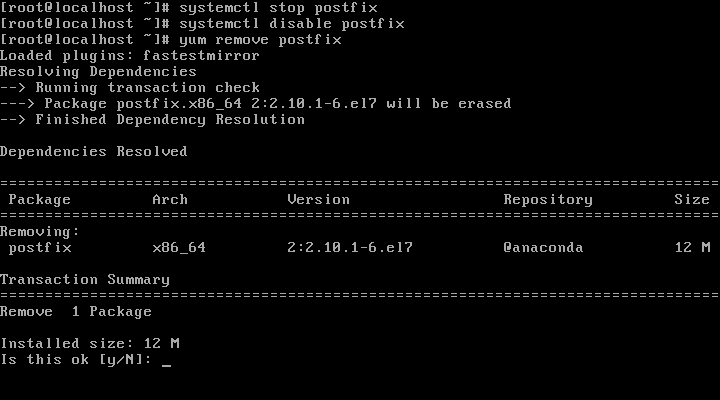
Une fois le service supprimé, le commande ss afin de vérifier si d’autres démons incompatibles avec le service Zimbra, tels que LDAP, httpd, dovecot sont en cours d’exécution sur votre système. Si tel est le cas, supprimez-les également.
Étape 5: Installez Zimbra Collaboration Suite Open Source Edition
7. Maintenant, il est temps d’installer Suite de collaboration Zimbra. Aller à Page de téléchargement de Zimbra Collaboration Suite et récupérez la dernière version de votre système en émettant ce qui suit commande wget:
----------------- For RHEL/CentOS 8 ----------------- # wget https://files.zimbra.com/downloads/8.8.15_GA/zcs-8.8.15_GA_3953.RHEL8_64.20200629025823.tgz ----------------- For RHEL/CentOS 7 ----------------- # wget https://files.zimbra.com/downloads/8.8.15_GA/zcs-8.8.15_GA_3869.RHEL7_64.20190918004220.tgz ----------------- For RHEL/CentOS 6 ----------------- # wget https://files.zimbra.com/downloads/8.8.15_GA/zcs-8.8.15_GA_3869.RHEL6_64.20190918004220.tgz

8. Une fois le téléchargement terminé, utilisez décompresser pour extraire l’archive, entrez le répertoire extrait de Zimbra et répertoriez le contenu du répertoire pour localiser le fichier d’installation.
# tar xfz zcs-8.8.15_GA_3953.RHEL8_64.20200629025823.tgz # cd zcs-8.8.15_GA_3953.RHEL8_64.20200629025823/ # ls
9. Maintenant, commence Zimbra processus d’installation en lançant en exécution le fichier script d’installation nommé install.sh.
Après une série de vérifications du système, le programme d’installation vous invite à accepter la licence. Accepter la licence (y) afin de poursuivre le processus d’installation.
# ./install.sh OR # ./install.sh --platform-override [On different platforms other than RHEL]
Exemple de sortie
Operations logged to /tmp/install.log.92OcKO6s
Checking for existing installation...
zimbra-drive...NOT FOUND
zimbra-imapd...NOT FOUND
zimbra-patch...NOT FOUND
zimbra-mta-patch...NOT FOUND
zimbra-proxy-patch...NOT FOUND
zimbra-license-tools...NOT FOUND
zimbra-license-extension...NOT FOUND
zimbra-network-store...NOT FOUND
zimbra-network-modules-ng...NOT FOUND
zimbra-chat...NOT FOUND
zimbra-talk...NOT FOUND
zimbra-ldap...NOT FOUND
zimbra-logger...NOT FOUND
zimbra-mta...NOT FOUND
zimbra-dnscache...NOT FOUND
zimbra-snmp...NOT FOUND
zimbra-store...NOT FOUND
zimbra-apache...NOT FOUND
zimbra-spell...NOT FOUND
zimbra-convertd...NOT FOUND
zimbra-memcached...NOT FOUND
zimbra-proxy...NOT FOUND
zimbra-archiving...NOT FOUND
zimbra-core...NOT FOUND
----------------------------------------------------------------------
PLEASE READ THIS AGREEMENT CAREFULLY BEFORE USING THE SOFTWARE.
SYNACOR, INC. ("SYNACOR") WILL ONLY LICENSE THIS SOFTWARE TO YOU IF YOU
FIRST ACCEPT THE TERMS OF THIS AGREEMENT. BY DOWNLOADING OR INSTALLING
THE SOFTWARE, OR USING THE PRODUCT, YOU ARE CONSENTING TO BE BOUND BY
THIS AGREEMENT. IF YOU DO NOT AGREE TO ALL OF THE TERMS OF THIS
AGREEMENT, THEN DO NOT DOWNLOAD, INSTALL OR USE THE PRODUCT.
License Terms for this Zimbra Collaboration Suite Software:
https://www.zimbra.com/license/zimbra-public-eula-2-6.html
----------------------------------------------------------------------
Do you agree with the terms of the software license agreement? [N] y
dix. Ensuite, le processus d’installation vous posera une série de questions afin de configurer correctement le démon Zimbra. Utilisez l’extrait d’installation ci-dessous afin de configurer davantage le service Zimbra.
Use Zimbra's package repository [Y] y
Importing Zimbra GPG key
Configuring package repository
Checking for installable packages
Found zimbra-core (local)
Found zimbra-ldap (local)
Found zimbra-logger (local)
Found zimbra-mta (local)
Found zimbra-dnscache (local)
Found zimbra-snmp (local)
Found zimbra-store (local)
Found zimbra-apache (local)
Found zimbra-spell (local)
Found zimbra-memcached (repo)
Found zimbra-proxy (local)
Found zimbra-drive (repo)
Found zimbra-imapd (local)
Found zimbra-patch (repo)
Found zimbra-mta-patch (repo)
Found zimbra-proxy-patch (repo)
Select the packages to install
Install zimbra-ldap [Y] y
11. Ensuite, il vous demandera d’installer les packages Zimbra, appuyez sur Y pour tout installer.
Select the packages to install Install zimbra-ldap [Y]yInstall zimbra-logger [Y]yInstall zimbra-mta [Y]yInstall zimbra-dnscache [Y]yInstall zimbra-snmp [Y]yInstall zimbra-store [Y]yInstall zimbra-apache [Y]yInstall zimbra-spell [Y]yInstall zimbra-memcached [Y]yInstall zimbra-proxy [Y]yChecking required space for zimbra-core Checking space for zimbra-store Checking required packages for zimbra-store zimbra-store package check complete. Installing: zimbra-core zimbra-ldap zimbra-logger zimbra-mta zimbra-dnscache zimbra-snmp zimbra-store zimbra-apache zimbra-spell zimbra-memcached zimbra-proxy zimbra-drive zimbra-imapd zimbra-patch zimbra-mta-patch zimbra-proxy-patch zimbra-chat
12. Enfin, il lancera le processus d’installation de Zimbra.
The system will be modified. Continue? [N] y
Beginning Installation - see /tmp/install.log.92OcKO6s for details...
zimbra-core-components will be downloaded and installed.
zimbra-common-core-jar will be installed.
zimbra-common-core-libs will be installed.
zimbra-common-mbox-conf will be installed.
zimbra-common-mbox-conf-attrs will be installed.
zimbra-common-mbox-conf-msgs will be installed.
zimbra-common-mbox-conf-rights will be installed.
zimbra-common-mbox-db will be installed.
zimbra-common-mbox-docs will be installed.
zimbra-common-mbox-native-lib will be installed.
zimbra-timezone-data will be installed.
zimbra-core will be installed.
zimbra-ldap-components will be downloaded and installed.
zimbra-ldap will be installed.
zimbra-logger will be installed.
zimbra-mta-components will be downloaded and installed.
zimbra-mta will be installed.
zimbra-dnscache-components will be downloaded and installed.
zimbra-dnscache will be installed.
zimbra-snmp-components will be downloaded and installed.
zimbra-snmp will be installed.
Last metadata expiration check: 0:00:56 ago on Sat 01 Aug 2020 01:56:00 AM EDT.
zimbra-jetty-distribution will be downloaded and installed.
zimbra-store-components will be downloaded and installed.
zimbra-mbox-admin-console-war will be installed.
zimbra-mbox-conf will be installed.
zimbra-mbox-war will be installed.
zimbra-mbox-service will be installed.
zimbra-mbox-store-libs will be installed.
zimbra-mbox-webclient-war will be installed.
zimbra-store will be installed.
zimbra-apache-components will be downloaded and installed.
zimbra-apache will be installed.
zimbra-spell-components will be downloaded and installed.
zimbra-spell will be installed.
Last metadata expiration check: 0:01:07 ago on Sat 01 Aug 2020 01:56:00 AM EDT.
zimbra-memcached will be downloaded and installed.
zimbra-proxy-components will be downloaded and installed.
zimbra-proxy will be installed.
Last metadata expiration check: 0:01:18 ago on Sat 01 Aug 2020 01:56:00 AM EDT.
zimbra-drive will be downloaded and installed (later).
zimbra-imapd will be installed.
Last metadata expiration check: 0:01:20 ago on Sat 01 Aug 2020 01:56:00 AM EDT.
zimbra-patch will be downloaded and installed (later).
Last metadata expiration check: 0:01:22 ago on Sat 01 Aug 2020 01:56:00 AM EDT.
zimbra-mta-patch will be downloaded and installed (later).
Last metadata expiration check: 0:01:23 ago on Sat 01 Aug 2020 01:56:00 AM EDT.
zimbra-proxy-patch will be downloaded and installed (later).
Last metadata expiration check: 0:01:27 ago on Sat 01 Aug 2020 01:56:00 AM EDT.
zimbra-chat will be downloaded and installed (later).
Downloading packages (11):
zimbra-core-components
zimbra-ldap-components
zimbra-mta-components
zimbra-dnscache-components
zimbra-snmp-components
zimbra-jetty-distribution
zimbra-store-components
zimbra-apache-components
zimbra-spell-components
zimbra-memcached
zimbra-proxy-components
...done
Removing /opt/zimbra
Removing zimbra crontab entry...done.
Cleaning up zimbra init scripts...done.
Cleaning up /etc/security/limits.conf...done.
Finished removing Zimbra Collaboration Server.
Installing repo packages (11):
zimbra-core-components
zimbra-ldap-components
zimbra-mta-components
zimbra-dnscache-components
zimbra-snmp-components
zimbra-jetty-distribution
zimbra-store-components
zimbra-apache-components
zimbra-spell-components
zimbra-memcached
zimbra-proxy-components
...
13. Configuration du magasin.
1) Status: Enabled 2) Create Admin User: yes 3) Admin user to create: [email protected] ** 4) Admin Password UNSET 5) Anti-virus quarantine user: [email protected] 6) Enable automated spam training: yes 7) Spam training user: [email protected] 8) Non-spam(Ham) training user: [email protected] 9) SMTP host: mail.centos7.lan 10) Web server HTTP port: 8080 11) Web server HTTPS port: 8443 12) Web server mode: https 13) IMAP server port: 7143 14) IMAP server SSL port: 7993 15) POP server port: 7110 16) POP server SSL port: 7995 17) Use spell check server: yes 18) Spell server URL: http://mail.centos7.lan:7780/aspell.php 19) Enable version update checks: TRUE 20) Enable version update notifications: TRUE 21) Version update notification email: [email protected] 22) Version update source email: [email protected] 23) Install mailstore (service webapp): yes 24) Install UI (zimbra,zimbraAdmin webapps): yes Select, or 'r' for previous menu [r]4# Select 4 to set admin password Password for [email protected] (min 6 characters): [54mE0RmqN]enter admin password here
Store configuration
1) Status: Enabled
2) Create Admin User: yes
3) Admin user to create: [email protected]
4) Admin Password set
5) Anti-virus quarantine user: [email protected]
6) Enable automated spam training: yes
7) Spam training user: [email protected]
8) Non-spam(Ham) training user: [email protected]
9) SMTP host: mail.centos7.lan
10) Web server HTTP port: 8080
11) Web server HTTPS port: 8443
12) Web server mode: https
13) IMAP server port: 7143
14) IMAP server SSL port: 7993
15) POP server port: 7110
16) POP server SSL port: 7995
17) Use spell check server: yes
18) Spell server URL: http://mail.centos7.lan:7780/aspell.php
19) Enable version update checks: TRUE
20) Enable version update notifications: TRUE
21) Version update notification email: [email protected]
22) Version update source email: [email protected]
23) Install mailstore (service webapp): yes
24) Install UI (zimbra,zimbraAdmin webapps): yes
Select, or 'r' for previous menu [r] r
Main menu 1) Common Configuration: 2) zimbra-ldap: Enabled 3) zimbra-logger: Enabled 4) zimbra-mta: Enabled 5) zimbra-dnscache: Enabled 6) zimbra-snmp: Enabled 7) zimbra-store: Enabled 8) zimbra-spell: Enabled 9) zimbra-proxy: Enabled 10) Default Class of Service Configuration: s) Save config to file x) Expand menu q) Quit *** CONFIGURATION COMPLETE - press 'a' to apply Select from menu, or press 'a' to apply config (? - help)a# Apply configuration Save configuration data to a file? [Yes]EnterSave config in file: [/opt/zimbra/config.11047] Saving config in /opt/zimbra/config.11047...done. The system will be modified - continue? [No]yesOperations logged to /tmp/zmsetup01262016-002704.log Setting local config values...done. Initializing core config...Setting up CA...done. Deploying CA to /opt/zimbra/conf/ca ...done. Creating SSL zimbra-store certificate...done. Creating new zimbra-ldap SSL certificate...done. Creating new zimbra-mta SSL certificate...done. Creating new zimbra-proxy SSL certificate...done. Installing mailboxd SSL certificates...done. Installing MTA SSL certificates...done. Installing LDAP SSL certificate...done. Installing Proxy SSL certificate...done. Initializing ldap...done. Setting replication password...done. Setting Postfix password...done. Setting amavis password...done. Setting nginx password...done. Setting BES searcher password...done. Creating server entry for mail.centos7.lan...done. Setting Zimbra IP Mode...done. Saving CA in ldap ...done. Saving SSL Certificate in ldap ...done. Setting spell check URL...done. Setting service ports on mail.centos7.lan...done. Setting zimbraFeatureTasksEnabled=TRUE...done. Setting zimbraFeatureBriefcasesEnabled=TRUE...done. Setting Master DNS IP address(es)...done. Setting DNS cache tcp lookup preference...done. Setting DNS cache udp lookup preference...done. Setting DNS tcp upstream preference...done. Setting TimeZone Preference...done. Initializing mta config...done. Setting services on mail.centos7.lan...done. Adding mail.centos7.lan to zimbraMailHostPool in default COS...done. Creating domain mail.centos7.lan...done. Setting default domain name...done. Creating domain mail.centos7.lan...already exists. Creating admin account [email protected] Creating root alias...done. Creating postmaster alias...done. Creating user [email protected] Creating user [email protected] Creating user [email protected] Setting spam training and Anti-virus quarantine accounts...done. Initializing store sql database...done. Setting zimbraSmtpHostname for mail.centos7.lan...done. Configuring SNMP...done. Setting up syslog.conf...done. Starting servers...done. Installing common zimlets... com_zimbra_adminversioncheck...done. com_zimbra_attachcontacts...done. com_zimbra_attachmail...done. com_zimbra_bulkprovision...done. com_zimbra_cert_manager...done. com_zimbra_clientuploader...done. com_zimbra_date...done. com_zimbra_email...done. com_zimbra_mailarchive...done. com_zimbra_phone...done. com_zimbra_proxy_config...done. com_zimbra_srchhighlighter...done. com_zimbra_tooltip...done. com_zimbra_url...done. com_zimbra_viewmail...done. com_zimbra_webex...done. com_zimbra_ymemoticons...done. Finished installing common zimlets. Restarting mailboxd...done. Creating galsync account for default domain...done. You have the option of notifying Zimbra of your installation. This helps us to track the uptake of the Zimbra Collaboration Server. The only information that will be transmitted is: The VERSION of zcs installed (8.6.0_GA_1153_RHEL7_64) The ADMIN EMAIL ADDRESS created ([email protected]) Notify Zimbra of your installation? [Yes]noNotification skipped Setting up zimbra crontab...done. Moving /tmp/zmsetup01262016-002704.log to /opt/zimbra/log Configuration complete - press return to exit #Press Enter
Étape 6: Configuration initiale de Zimba
14. Une fois l’installation terminée, ouvrez un navigateur Web et accédez à votre nom de domaine ou à l’adresse IP de la machine exécutant le service Zimbra, sur le port 7071 via le protocole HTTPS, acceptez l’erreur de sécurité du certificat et connectez-vous avec les informations d’identification configurées pendant le processus d’installation. Le nom d’utilisateur par défaut du panneau Web d’administration de Zimbra est admin.
https://mail.centos7.lan:7071 or https://192.168.1.14:7071
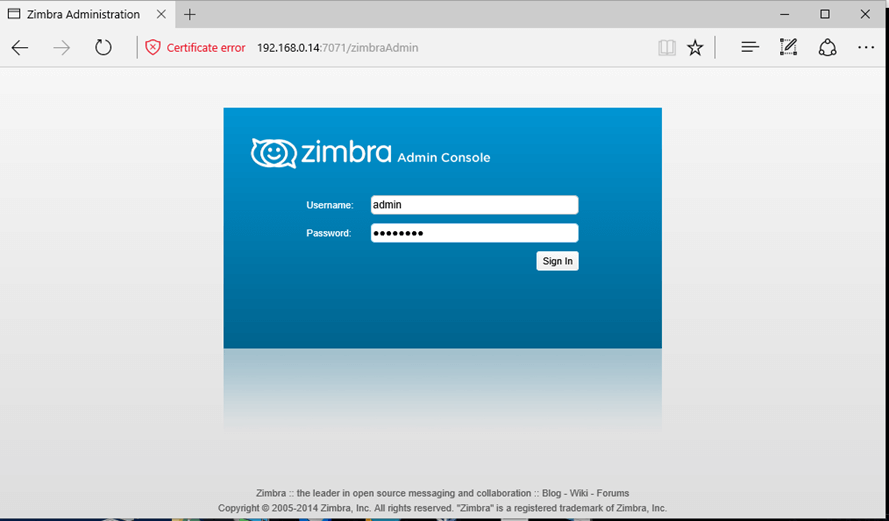
15. Une fois connecté à la console Web d’administration, vous pouvez commencer à ajouter le vôtre SSL certificats, créez des comptes de messagerie, des alias de messagerie, etc. Souviens-toi juste que le port 7071 est utilisé uniquement pour les tâches administratives.
Les clients peuvent se connecter en toute sécurité à leurs boîtes de messagerie Web en utilisant le nom de domaine ou l’adresse IP du serveur via le protocole HTTPS.
https://mail.centos7.lan or https://192.168.1.14
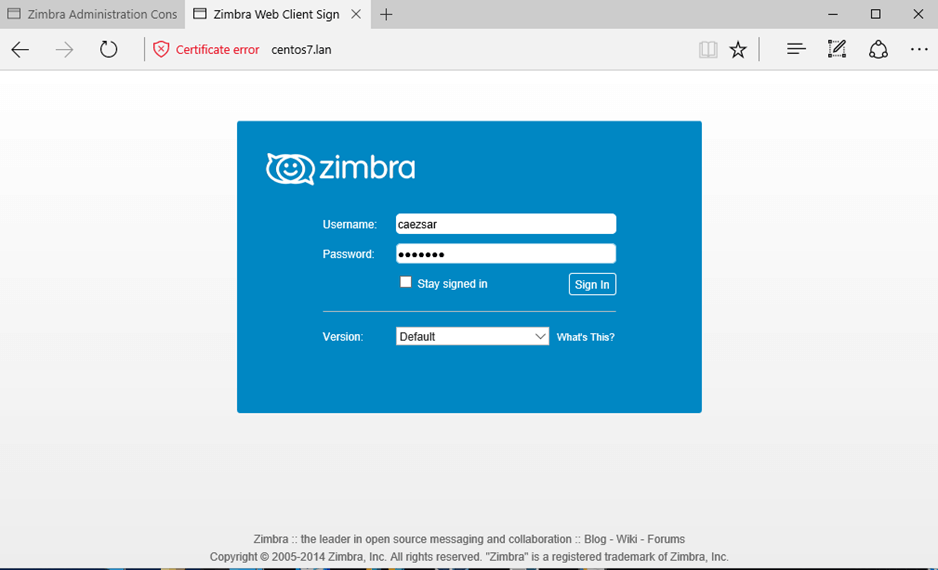
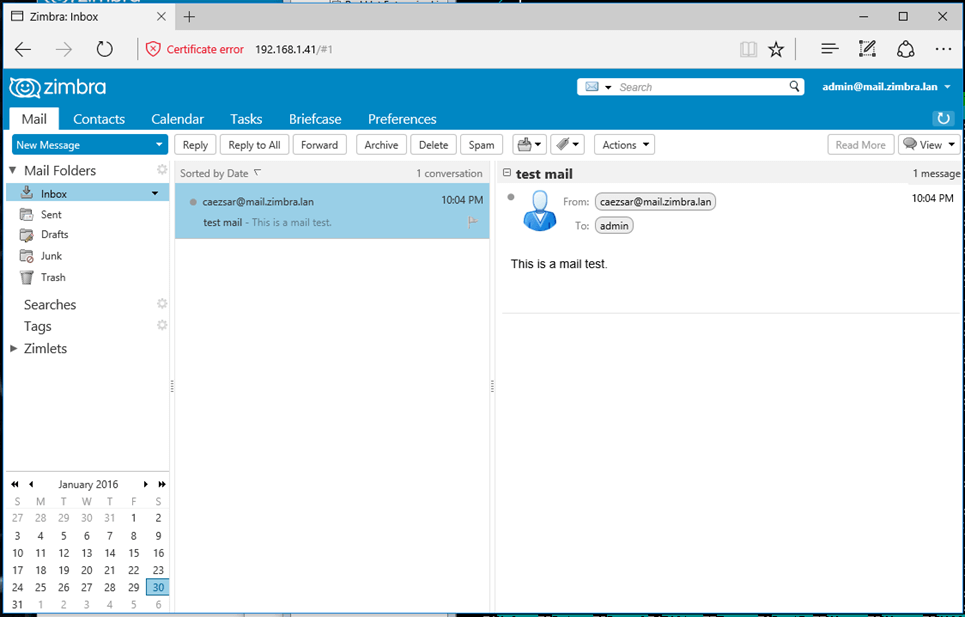
Toutes nos félicitations! Vous disposez désormais d’une pile de messagerie opérationnelle complète installée dans vos locaux.
Étape 6: Retirez ou désinstallez Zimbra
Si vous souhaitez désinstaller le service Zimbra avec ses composants, exécutez le script d’installation avec le -u option.
# ./install.sh -u
Pour supprimer l’archive et le répertoire d’installation de Zimbra, exécutez les commandes ci-dessous:
# cd # rm -rf zcs-*
En guise de note finale, pour exécuter correctement Zimbra Collaboration Suite, vous avez besoin d’une machine puissante avec un minimum de 4 Go de RAM.
.





![10 exemples de commandes Gzip [Compress Files in Linux]](https://media.techtribune.net/uploads/2023/06/Gzip-Command-in-Linux-238x178.png)




